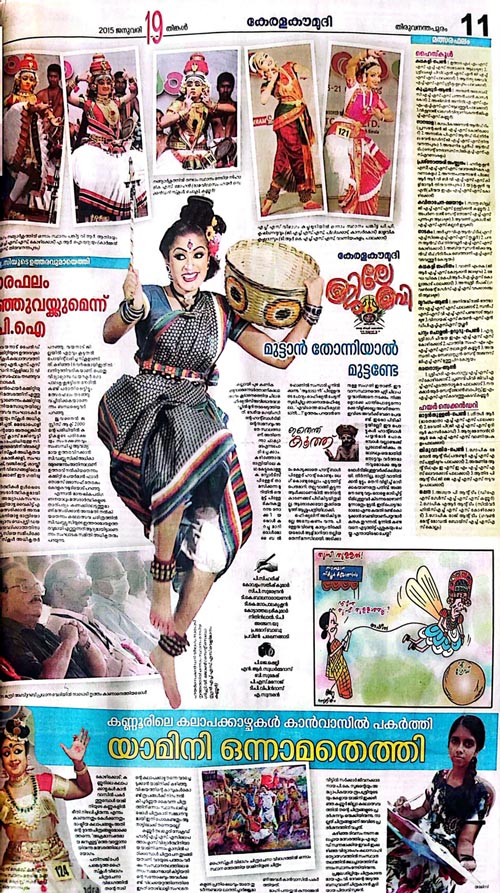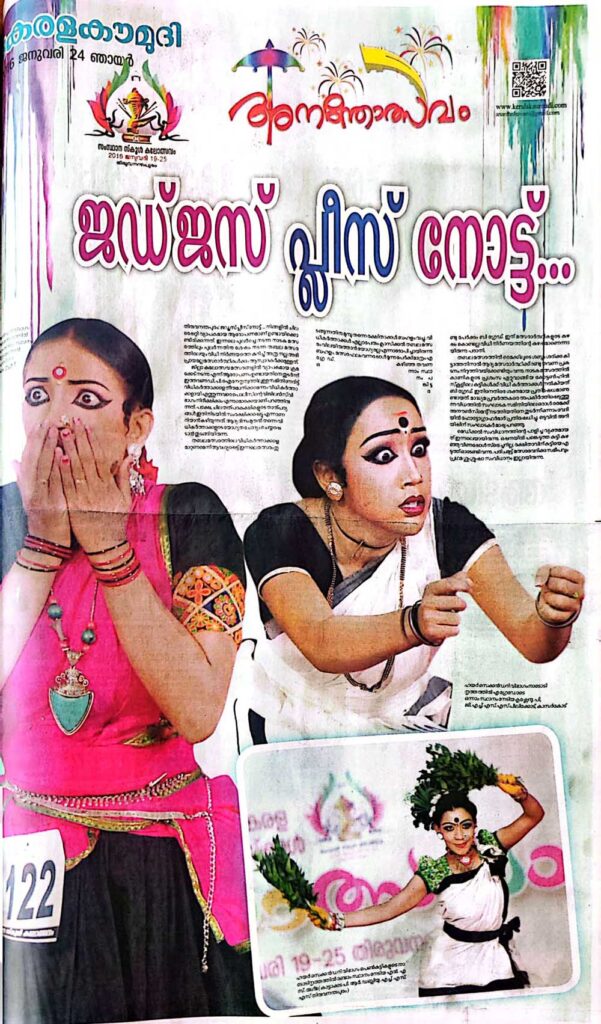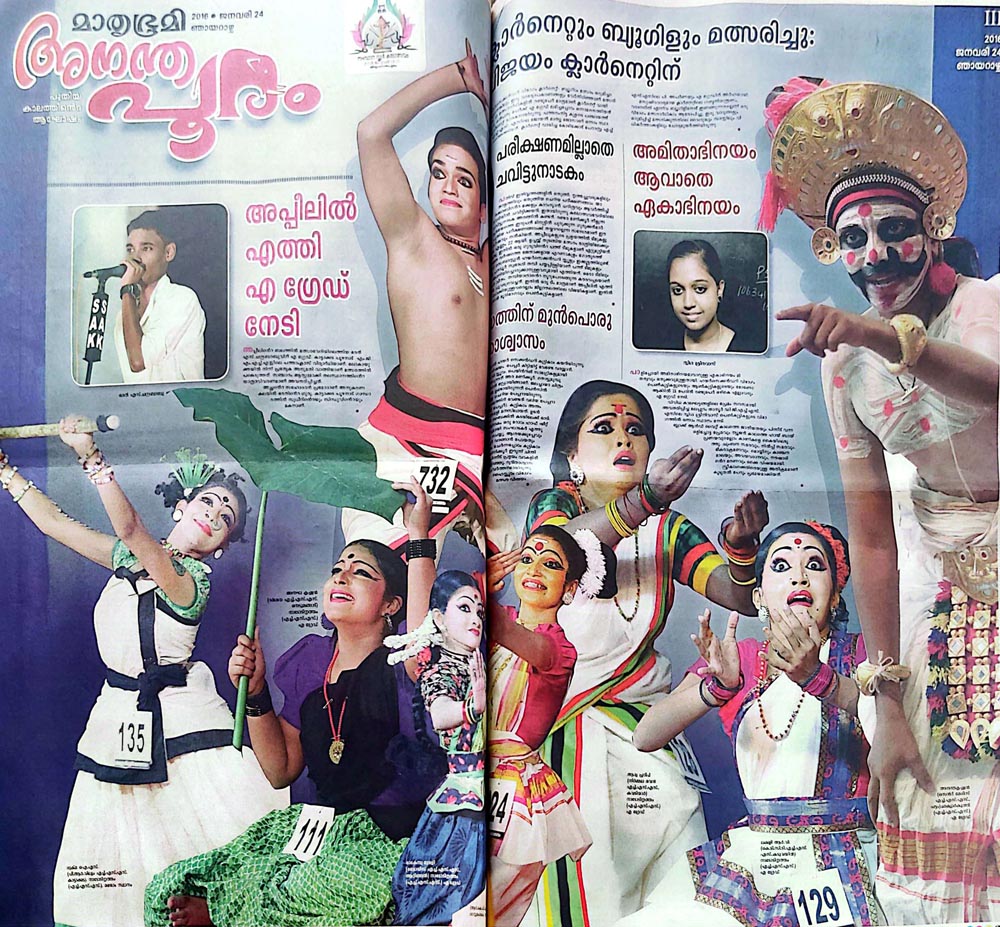‘Nadodi nruttham’ is an omnipresent cultural form in Kerala’s arts festival spaces. Drawing from her ongoing research into youth festivals in Kerala, Rajashree Raju delves into the caste dynamics behind a form that represents itself as ‘folk’.
Rajashree Raju
The Kollam City Town Hall was packed with audiences eagerly watching the girls’ nadodi nrutham competition—translated as ‘folk dance’ in official documents but literally meaning ‘the dances of the nomads.’ This competition was held as part of the 62nd edition of the Kerala School Kalolsavam, a government-sponsored annual cultural arts competition for school children in Kerala. Formerly known as the Yuvajanolsavam (youth festival), this festival was introduced in the state in 1957, just months after Kerala’s formation, with competitions in dance, music, visual, and literary art forms. The festival has, over the years, contributed greatly to the creation of an officially sanctioned culture in Kerala and has grown into a massive state-level cultural arts competition, now promoted by the state government and regional media as Asia’s largest cultural event. For instance, the most recent festival, held in January 2024, spanned seven days, drawing 12,000 participants from across the state in 239 competitions, held at 24 different venues. Nadodi nrutham has been a part of the kalolsavam since its emergence in 1957, and over the years, this dance form has come to be associated with Malayali sub-national culture, often showcased at national and international festivals representing Kerala.
‘Judges, please note, code number 114,’ the announcer’s voice echoed through the auditorium, and a hush fell over the crowd. The curtain gently rose as the music swelled, filling the space. A dancer in a colourful costume appeared on stage, telling a tragic story of a helpless victim. Every dancer who followed embraced a similar theme and choreography, and after every performance, enthusiastic applause resonated through the auditorium, affirming that the nadodi nrutham competition is indeed a crowd puller.

In most of the performances, the dancers embodied people from caste-oppressed communities, such as palm-reading Kurathi women, Tamil-speaking vegetable sellers, and landless Cheruma peasants. I noticed that the music used had a cinematic quality, with studio-recorded singing and musical instruments typically found in film music, such as the clarinet, keyboard, harmonium, tabla, drums, and mridangam. Most of the performances featured dancers dressed in bright, colourful costumes, elaborate hairdos with accessories, and adorned with stone jewellery, resembling the sartorial choices commonly associated with caste-oppressed communities as represented in theatre and films. The dancers’ makeup resembled that typically used in ‘classical’ dance competitions—bright and light-coloured foundation for a fair appearance, heavily lined eyes, defined eyebrows, bold red lipstick, and large, colourful bindis.
As far as the storyline of the nadodi nrutham performances is concerned, Pradeepan Pampirikkunnu observed in an article published in the magazine ‘Malayalam’ in 2010 that the most recurring themes ranged from illicit pregnancy, rape, and destruction of traditional livelihoods of the oppressed, to the husband’s death and globalisation (Pambirikkunnu 2010, 92-3). The performances I watched were no different. For instance, in one performance, the dancer embodied the character of an impoverished single mother who toils in the field to raise her daughter and dies by suicide after her daughter is raped and murdered by rich and powerful men from the oppressor caste communities.
The student participants began the performance with fast-paced dance movements that were synchronised with the music and accompanied by pleasant smiles. The movements were a mix of simplified ‘classical’ dance movements, mudras (hand gestures), and steps from cinematic dance and various ‘folk’ dance forms. Another common feature of the performances was the exaggerated facial expressions. As the plot thickened, the music slowed, and the dancers collapsed to the ground and cried, emoting the helplessness and sadness of the characters they portrayed. Each performance concluded with the dancer delivering a moral message to the audience.

The judging criterion for the nadodi nrutham competitions as mentioned in the kalolsavam manual1 align closely with those used in ‘classical’ dance competitions. For example, the latest kalolsavam manual awards twenty marks each for aakarasushama (beauty of form), vesham (costume), bhaavaprakatanam (expression), thaalam (rhythmic pattern/ beat), and chalanabhangi (beauty of movement). These criteria are consistent with the performance standards found in Sanskrit texts such as the Natyashastra and Abhinayadarpana. However, apart from these formal criteria, the judges I spoke to mentioned that in addition to the quality of choreography and performance, an important aspect of their grading is the educative message conveyed through the performances’ storylines. This means that each year, new songs are created with sentimental and melodramatic storylines about the lives of people from oppressed communities to impress the judges.
This shows that nadodi nrutham—interchangeably referred to as nadan nrutham (folk dance)—is not a traditional dance form associated with a specific communal identity or ritual context. It is thus different from the ‘classical’ dance forms, which incorporate themes from Hindu puranas and epics to preserve a sense of historical continuity with an imagined ancient Sanskritic Hindu past, considered the heart of Indian national culture. It is also unlike the ritualistic or traditional ‘folk’ art forms that have become central to Kerala’s subnational identity, such as thiruvathirakali, oppana, or margamkali, performed popularly as a means to showcase the diversity of Malayali culture. As such, the inclusion of nadodi nrutham in the kalolsavam raises several questions: does it have an independent history or was it created for the kalolsavam in the 1950s? Was it developed out of a belief that existing ‘folk’ dance and music lacked sophistication? What purpose does it serve?
In the official documents such as the manuals and pamphlets published by the Education Department of Kerala, nadodi nrutham is defined as a ‘folk’-dance style of Kerala and a representation of the dance forms performed by nomadic communities in the state. At the same time, the question of the ‘authenticity’ of the nadodi nrutham competitions at the kalolsavam was a topic of discussion in an interview published in the kalolsavam souvenir in 1969. In it, the interviewer V R Parameshwaran Nair, an educator and kalolsavam organiser, asks well-known dramatist C N Sreekandan Nair how one might define ‘folk’ dance, to which Sreekandan Nair responds:
‘Dance forms that do not have a rigid grammar, are part of people’s daily lives and have been practised by them in their respective regions for generations can be categorised as folk.’ (Nair 1969, 44-5)
Later, in the same interview, he affirms that what is being performed by students at the kalolsavam as ‘folk’ dance is clearly not the dances of the ‘folk’ or ‘people’. In this context, it is important to acknowledge that kalolsavam as an institution has excluded traditional art forms practiced by people from caste-oppressed communities. Since its inception in the 1950s, the festival has been controlled and led by oppressor castes, who have not paid heed to the demands of the artists and scholars demanding the inclusion of Adivasi art forms in the kalolsavam (Sreejith 2024). As a result, like in the exchange cited above, the conversation about what constitutes ‘folk’ is also dictated by oppressor castes, which means that the oppressed peoples’ cultures are interpreted and represented through the lens of savarna2 culture. Moreover, in my interview with a senior dance trainer who won the girls’ nadodi nrutham competition at the kalolsavam in the 1950s, she fondly recalled,
‘My teacher, who trained me for the nadodi nrutham competitions, really had a huge impact on my journey…I became her student when she was just starting out as a dance teacher… She was married to a civil servant, and I remember how she used to tell us stories about travelling with him during his postings all over the country before settling in Kerala. It was during those travels that she watched performances by different Adivasi communities, and her nadodi nrutham choreographies were all inspired by what she saw…Most of her songs were about the lives of kurathis and kuravans. After a few of us, her students, started winning prizes in nadodi nrutham competitions at the youth festival, her work really started to get noticed… Nadodi nrutham became her speciality, and up until the end of her life, she had students from all across Kerala coming to learn her pieces.’3
As is clear from the interview, the teacher wrote nadodi nrutham songs about the lives of people from oppressed communities, drawing on her experiences of having watched their performances during her travels. This means that the nadodi nrutham performed at the kalolsavam, although purported as a ‘folk’ dance representing the cultural practices of oppressed communities, has actually been constructed by the oppressor castes.
For instance, consider the performance of a popular nadodi nrutham piece, written and choreographed by Kalamandalam Gopinath, about a murukku seller. This performance begins with the dancer introducing herself as Meenakshi, a woman from Tamil Nadu who sells murukku in the markets of the Palakkad district in Kerala. The dancer is dressed in a colourful half saree, which is commonly worn by women in Tamil Nadu. The lyrics of the song are written in a mixture of Tamil and Malayalam. By doing this, the author has already managed to draw a boundary between the Malayali audience and the oppressed protagonist, who is portrayed as the Tamil-speaking ‘other.’ As the narrative progresses, her suffering as the ‘other’ is described in detail. After the introduction of her character, the narrative of the performance takes the audience to a crowded temple festival in Palakkad, where she is selling murukku. There, she finds a lost baby boy and consoles him. However, the public soon abuses her—slapping, spitting on her, and accusing her of being a thief, mistaking her for a child kidnapper. The audience is then invited to sympathise with her as she describes her plight as a mother who has lost her child.
The performance thus reflects the oppressor castes’ interpretation and perception of the lives and cultural expressions of the oppressed caste groups, rather than an inclusion of those communities’ traditional practices. At the same time, unlike ‘classical’ dance forms, which have strict grammar and prescribed body movements, nadodi nrutham is kept flexible to evolve both in terms of choreography and themes. Besides, nadodi nrutham is extremely popular at the kalolsavam and garners many participants and extensive media coverage every year. Student participants at the kalolsavam appreciate the opportunity to take part in the nadodi nrutham competitions without the need for prolonged training. Moreover, many of the kalolsavam audience members I interviewed confirmed this, attributing the popularity of the dance form to its accessibility, even for those without prior knowledge of the arts.

Newspaper reports also highlight the popularity of nadodi nrutham performances. For instance, in a report published by the Indian Express as early as 1981, titled ‘The Youth Show That Captivated Palghat,’ the author notes that one of the most popular competitions that ‘turned the masses hysterical’ included ‘folk’ dance. According to the reporter, ‘the free movements of these dances titillate the earthy sentiments of the general public.’ In this context, it seems that while nadodi nrutham is framed as accessible and comprehensible for any Malayali to appreciate, it is evident that it represents the lives of people from caste-oppressed communities through the lens of savarna cultural imagination, reaffirming the excluded status of these communities. Its popularity as a traditional Malayali art form also comes at the cost of excluding the cultural practices of oppressed communities in sites such as the kalolsavam.
This exclusion was evident even in the kalolsavam hosted exclusively for transgender individuals by the Social Justice Department in Kerala. For instance, at the 2022 festival, Sanjana Chandran, a participant in the nadodi nrutham competition, raised concerns when her performance was overlooked for a prize. The judges assessed her dance using ‘classical’ standards, just as in the school kalolsavam, stating that her bhaava (expressions) did not meet their expectations. In an interview, Sanjana pointed out that, unlike the school kalolsavam, the transgender kalolsavam manual for nadodi nrutham clearly requires participants to perform traditional ‘folk’ dance forms. She noted that hers was the only performance meeting this criterion, as she performed a traditional dance form practiced by the Adivasi Paniyar community in Wayanad, where ‘classical’ standards such as bhaava do not apply (Chandran 2022). Despite her protests, the prize was awarded to a dancer who performed the version of nadodi nrutham popularised through the school kalolsavams.
These dynamics suggest that nadodi nrutham serves as an instrument of exclusion in sites like the kalolsavam, where Malayali sub-national culture is being shaped—an endeavour historically rooted in exclusion. In sum, the very dance form that was meant to be inclusive—both in terms of participation by not enforcing strict ‘classical’ dance standards, and in terms of viewership by incorporating popular cinematic elements to engage a broader audience—employs content that serves to simultaneously define and eject certain social groups as outside Malayali, is worth pondering on more deeply. Moreover, this underscores how kalolsavam serves as a potent institutional site for reproducing and reinforcing the social power that has historically shaped Malayali identity since the late nineteenth century in Kerala.
References
- Chandran, S. 2022. ‘Deviyude Soundaryamillathathinaal Markku Kurakkunna Kalolsava Vedhikal’ [Arts Festivals That Deduct Marks for Not Having The Devi’s Beauty]. DoolNews, October 2, 2022. https://www.youtube.com/watch?v=P9_x7QlRpq0
- Nair, V. R. P. 1969. ‘Onpathu chodyam: Onpathutharam’ [Nine Questions, Nine Answers]. In Kerala Samsthana Yujajanotsavam (pp. 44–45). Irinjalakkuda: Executive Committee of the 11th Kerala State Youth Festival.
- Pampirikkunnu, Pradeepan. 2010. ‘Nadodi nrutham enna vikrutha roopam’ [The Grotesque Art Form of Nadodi Nruttham]. Malayalam, May 28, 2010.
- Sreejith, A. K. 2024. ‘Kerala State School Kalolsavam ousts tribal art forms even in its 61st edition’. Mathrubhumi, January 25, 2024. https://english.mathrubhumi.com/news/kerala/kerala-state-school-kalolsavam-ousts-tribal-art-forms-even-in-its-61st-edition-1.8184815
About the Author: Rajashree Raju is a PhD researcher in the Department of South Asian Studies at the University of Tübingen, Germany.
